Characteristic and Driving Factors of Aerosol Optical Depth over Mainland China during 1980–2017
Abstract
1. Introduction
2. Materials and Methods
2.1. Study Area and Data
2.1.1. Observation Data
2.1.2. MODIS and MERRA-2 Products
2.1.3. Socioeconomic Data
2.1.4. Climate Zones and Terrain Features
2.2. Trend Analysis Method
2.2.1. Mann-Kendall Index
2.2.2. Sen’s Slope Index
2.3. Statistical Indicators
3. Results
3.1. Validation of AODProducts
3.2. Spatial and Temporal Variations of AODin China
3.2.1. Annual Variations of AOD in China
3.2.2. Spatial and Temporal Variations of AOD in China
3.2.3. Temporal Trends of AOD in China
4. Discussions
4.1. The Composition of AOD over Mainland China
4.2. The Effect of Anthropogenic Aerosol Emissionson AOD
4.3. The Socioeconomic Factors for AOD
4.4. The Effect of Land-Use and Land-Cover Change on AOD
5. Conclusions
Author Contributions
Funding
Conflicts of Interest
Appendix A
| Land-Use Type | 1980 | 1990 | 1995 | 2000 | 2005 | 2010 | 2015 |
|---|---|---|---|---|---|---|---|
| Paddy Land | 0.107 | 0.158 | 0.164 | 0.199 | 0.314 | 0.352 | 0.291 |
| Dry Land | 0.106 | 0.159 | 0.156 | 0.206 | 0.276 | 0.328 | 0.286 |
| Forestland | 0.071 | 0.103 | 0.102 | 0.140 | 0.206 | 0.236 | 0.211 |
| Shrub Woodland | 0.061 | 0.106 | 0.106 | 0.138 | 0.213 | 0.260 | 0.211 |
| Sparse Woodland | 0.087 | 0.136 | 0.140 | 0.174 | 0.276 | 0.316 | 0.260 |
| Other Woodlands | 0.074 | 0.102 | 0.130 | 0.152 | 0.242 | 0.265 | 0.231 |
| High Coverage Grassland | 0.152 | 0.174 | 0.182 | 0.212 | 0.224 | 0.254 | 0.243 |
| Mid Coverage Grassland | 0.145 | 0.169 | 0.188 | 0.209 | 0.220 | 0.247 | 0.229 |
| Low Coverage Grassland | 0.133 | 0.149 | 0.140 | 0.185 | 0.182 | 0.205 | 0.190 |
| Canal Land | 0.219 | 0.263 | 0.266 | 0.307 | 0.390 | 0.430 | 0.387 |
| Lake | 0.145 | 0.168 | 0.174 | 0.208 | 0.234 | 0.256 | 0.236 |
| Reservoir Pit | 0.232 | 0.277 | 0.283 | 0.320 | 0.433 | 0.470 | 0.410 |
| Permanent Glacier Snow | 0.124 | 0.140 | 0.139 | 0.179 | 0.178 | 0.198 | 0.192 |
| Shoal | 0.221 | 0.254 | 0.148 | 0.278 | 0.367 | 0.394 | 0.349 |
| Bottomland | 0.180 | 0.209 | 0.220 | 0.245 | 0.276 | 0.315 | 0.291 |
| Urban Land | 0.234 | 0.279 | 0.283 | 0.333 | 0.424 | 0.469 | 0.423 |
| Rural Settlements | 0.244 | 0.299 | 0.298 | 0.358 | 0.448 | 0.500 | 0.456 |
| Other Constructive Land | 0.233 | 0.280 | 0.283 | 0.330 | 0.420 | 0.450 | 0.400 |
| Sand | 0.200 | 0.219 | 0.249 | 0.262 | 0.253 | 0.302 | 0.275 |
| Gobi | 0.168 | 0.180 | 0.190 | 0.210 | 0.198 | 0.229 | 0.202 |
| Saline Alkali Land | 0.173 | 0.182 | 0.199 | 0.219 | 0.212 | 0.250 | 0.228 |
| Marshland | 0.164 | 0.172 | 0.153 | 0.191 | 0.178 | 0.211 | 0.211 |
| Bare Land | 0.174 | 0.190 | 0.184 | 0.216 | 0.206 | 0.238 | 0.214 |
| Bare Rock Land | 0.137 | 0.147 | 0.158 | 0.188 | 0.183 | 0.208 | 0.194 |
| Other | 0.099 | 0.109 | 0.094 | 0.142 | 0.135 | 0.147 | 0.132 |
| Land-Use Type | 1980 | 1990 | 1995 | 2000 | 2005 | 2010 | 2015 |
|---|---|---|---|---|---|---|---|
| Paddy Land | 0.037 | 0.036 | 0.041 | 0.023 | 0.077 ** | 0.101 ** | 0.142 ** |
| Dry Land | 0.111 ** | 0.107 ** | 0.121 ** | 0.109 ** | 0.138 ** | 0.149 ** | 0.163 ** |
| Forestland | −0.004 | −0.062 ** | −0.071 ** | −0.126 ** | −0.169 ** | −0.152 ** | −0.110 ** |
| Shrub Woodland | −0.101 ** | −0.047 * | −0.025 | −0.059 ** | −0.041 * | −0.062 ** | −0.108 ** |
| Sparse Woodland | −0.205 ** | −0.260 ** | −0.225 ** | −0.279 ** | −0.270 ** | −0.246 ** | −0.202 ** |
| Other Woodlands | −0.155 ** | −0.155 ** | −0.124 ** | −0.146 ** | −0.213 ** | −0.241 ** | −0.216 ** |
| High Coverage Grassland | −0.418 ** | −0.392 ** | −0.281 ** | −0.380 ** | −0.360 ** | −0.364 ** | −0.380 ** |
| Mid Coverage Grassland | −0.365 ** | −0.388 ** | −0.386 ** | −0.388 ** | −0.393 ** | −0.404 ** | −0.435 ** |
| Low Coverage Grassland | −0.278 ** | −0.321 ** | −0.333 ** | −0.332 ** | −0.346 ** | −0.352 ** | −0.366 ** |
| Canal Land | 0.178 ** | 0.200 ** | 0.178 ** | 0.216 ** | 0.210 ** | 0.213 ** | 0.227 ** |
| Lake | 0.058 ** | 0.062 ** | 0.056 * | 0.080 ** | 0.080 ** | 0.079 ** | 0.100 ** |
| Reservoir Pit | 0.227 ** | 0.250 ** | 0.223 ** | 0.262 ** | 0.291 ** | 0.296 ** | 0.299 ** |
| Permanent Glacier Snow | −0.213 ** | −0.159 ** | −0.164 ** | −0.157 ** | −0.150 ** | −0.152 ** | −0.155 ** |
| Shoal | 0.092 ** | 0.089 ** | 0.096 ** | 0.088 ** | 0.125 ** | 0.125 ** | 0.106 ** |
| Bottomland | 0.017 | −0.02 | −0.024 | −0.014 | −0.054 ** | −0.015 | 0.012 |
| Urban Land | 0.336 ** | 0.379 ** | 0.375 ** | 0.421 ** | 0.434 ** | 0.425 ** | 0.436 ** |
| Rural Settlements | 0.218 ** | 0.192 ** | 0.162 ** | 0.149 ** | 0.153 ** | 0.184 ** | 0.232 ** |
| Other Constructive Land | 0.254 ** | 0.283 ** | 0.289 ** | 0.331 ** | 0.352 ** | 0.347 ** | 0.329 ** |
| Sand | −0.095 ** | −0.129 ** | −0.124 ** | −0.139 ** | −0.158 ** | −0.150 ** | −0.152 ** |
| Gobi | −0.121 ** | −0.135 ** | −0.151 ** | −0.150 ** | −0.158 ** | −0.161 ** | −0.163 ** |
| Saline Alkali Land | −0.080 ** | −0.123 ** | −0.110 ** | −0.146 ** | −0.158 ** | −0.155 ** | −0.144 ** |
| Marshland | −0.065 ** | −0.101 ** | −0.125 ** | −0.118 ** | −0.155 ** | −0.142 ** | −0.114 ** |
| Bare Land | −0.091 ** | −0.089 ** | −0.108 ** | −0.109 ** | −0.118 ** | −0.120 ** | −0.126 ** |
| Bare Rock Land | −0.298 ** | −0.292 ** | −0.294 ** | −0.287 ** | −0.278 ** | −0.280 ** | −0.289 ** |
| Other | −0.107 ** | −0.116 ** | −0.075 ** | −0.116 ** | −0.119 ** | −0.123 ** | −0.129 ** |
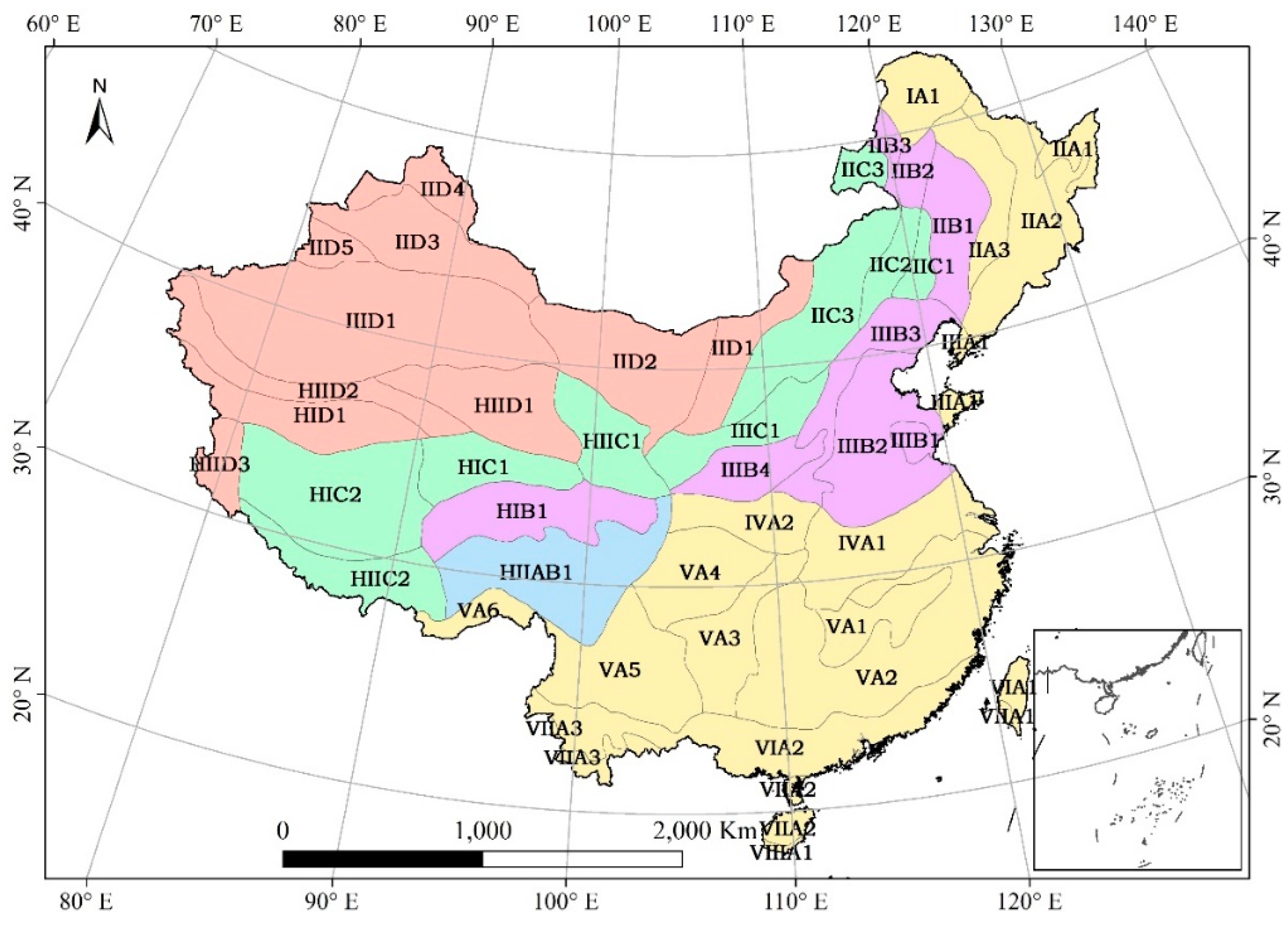
References
- Bellouin, N.; Boucher, O.; Haywood, J.; Reddy, M.S. Global estimate of aerosol direct radiative forcing from satellite measurements. Nature 2005, 438, 1138–1141. [Google Scholar] [CrossRef] [PubMed]
- Kirkevag, A.; Iversen, T. Global direct radiative forcing by process-parameterized aerosol optical properties. J. Geophys. Res.-Atmos. 2002, 107. [Google Scholar] [CrossRef]
- He, L.J.; Wang, L.C.; Lin, A.W.; Zhang, M.; Bilal, M.; Wei, J. Performance of the NPP-VIIRS and Aqua-MODIS aerosol optical depth products over the yangtze river basin. Remote Sens. 2018, 10, 117. [Google Scholar] [CrossRef]
- Zhang, W.H.; Xu, H.; Zheng, F.J. Aerosol optical depth retrieval over East Asia using Himawari-8/AHI data. Remote Sens. 2018, 10, 137. [Google Scholar] [CrossRef]
- Ma, X.; Yu, F.; Luo, G. Aerosol direct radiative forcing based on GEOS-Chem-APM and uncertainties. Atmos. Chem. Phys. 2012, 12, 5563–5581. [Google Scholar] [CrossRef]
- Hauser, A.; Oesch, D.; Foppa, N. Aerosol optical depth over land: Comparing AERONET, AVHRR and MODIS. Geophys. Res. Lett. 2005, 32. [Google Scholar] [CrossRef]
- Soni, K.; Parmar, K.S.; Kapoor, S.; Kumar, N. Statistical variability comparison in MODIS and AERONET derived aerosol optical depth over Indo-Gangetic Plains using time series modeling. Sci. Total Environ. 2016, 553, 258–265. [Google Scholar] [CrossRef] [PubMed]
- He, L.; Wang, L.; Lin, A.; Zhang, M.; Bilal, M.; Tao, M. Aerosol Optical Properties and Associated Direct Radiative Forcing over the Yangtze River Basin during 2001–2015. Remote Sens. 2017, 9, 746. [Google Scholar] [CrossRef]
- Che, H.Z.; Qi, B.; Zhao, H.J.; Xia, X.G.; Eck, T.F.; Goloub, P.; Dubovik, O.; Estelles, V.; Cuevas-Agullo, E.; Blarel, L.; et al. Aerosol optical properties and direct radiative forcing based on measurements from the China Aerosol Remote Sensing Network (CARSNET) in eastern China. Atmos. Chem. Phys. 2018, 18, 405–425. [Google Scholar] [CrossRef]
- Liu, X.Y.; Chen, Q.L.; Che, H.Z.; Zhang, R.J.; Gui, K.; Zhang, H.; Zhao, T.L. Spatial distribution and temporal variation of aerosol optical depth in the Sichuan basin, China, the recent ten years. Atmos. Environ. 2016, 147, 434–445. [Google Scholar] [CrossRef]
- Xie, Y.; Zhang, Y.; Xiong, X.X.; Qu, J.J.; Che, H.Z. Validation of MODIS aerosol optical depth product over China using CARSNET measurements. Atmos. Environ. 2011, 45, 5970–5978. [Google Scholar] [CrossRef]
- Torres, O.; Bhartia, P.K.; Herman, J.R.; Sinyuk, A.; Ginoux, P.; Holben, B. A Long-Term record of aerosol optical depth from TOMS observations and comparison to AERONET measurements. J. Atmos. Sci. 2002, 59, 398–413. [Google Scholar] [CrossRef]
- Esposito, F.; Pavese, G.; Serio, C. A preliminary study on the correlation between TOMS aerosol index and ground-based measured aerosol optical depth. Atmos. Environ. 2001, 35, 5093–5098. [Google Scholar] [CrossRef]
- Blackmore, T.; O’Carroll, A.; Fennig, K.; Saunders, R. Correction of AVHRR Pathfinder SST data for volcanic aerosol effects using ATSR SSTs and TOMS aerosol optical depth. Remote Sens. Environ. 2012, 116, 107–117. [Google Scholar] [CrossRef]
- Che, Y.; Xue, Y.; Mei, L.; Guang, J.; She, L.; Guo, J.; Hu, Y.; Xu, H.; He, X.; Di, A. Intercomparison of three AATSR Level 2 (L2) AOD products over China. Atmos. Chem. Phys. 2016, 16, 9655–9674. [Google Scholar] [CrossRef]
- Grey, W.; North, P.; Los, S.O.; Mitchell, R.M. Aerosol optical depth and land surface reflectance from Multiangle AATSR measurements: Global validation and intersensor comparisons. IEEE Trans. Geosci. Remote Sens. 2006, 44, 2184–2197. [Google Scholar] [CrossRef]
- Bevan, S.L.; North, P.; Los, S.O.; Grey, W. A global data set of atmospheric aerosol optical depth and surface reflectance from AATSR. Remote Sens. Environ. 2012, 116, 199–210. [Google Scholar] [CrossRef]
- Sayer, A.M.; Hsu, N.C.; Bettenhausen, C.; Jeong, M.J.; Holben, B.N.; Zhang, J. Global and regional evaluation of over-land spectral aerosol optical depth retrievals from SeaWiFS. Atmos. Meas. Tech. 2012, 5, 1761–1778. [Google Scholar] [CrossRef]
- Hsu, N.C.; Gautam, R.; Sayer, A.M.; Bettenhausen, C.; Li, C.; Jeong, M.J.; Tsay, S.C.; Holben, B.N. Global and regional trends of aerosol optical depth over land and ocean using SeaWiFS measurements from 1997 to 2010. Atmos. Chem. Phys. 2012, 12, 8037–8053. [Google Scholar] [CrossRef]
- Melin, F.; Zibordi, G.; Djavidnia, S. Development and validation of a technique for merging satellite derived aerosol optical depth from SeaWiFS and MODIS. Remote Sens. Environ. 2007, 108, 436–450. [Google Scholar] [CrossRef]
- Hauser, A.; Oesch, D.; Foppa, N.; Wunderle, S. NOAA AVHRR derived aerosol optical depth over land. J. Geophys. Res. Atmos. 2005, 110. [Google Scholar] [CrossRef]
- Li, Y.; Xue, Y.; de Leeuw, G.; Li, C.; Yang, L.; Hou, T.; Marir, F. Retrieval of aerosol optical depth and surface reflectance over land from NOAA AVHRR data. Remote. Sens. Environ. 2013, 133, 1–20. [Google Scholar] [CrossRef]
- Gao, L.; Li, J.; Chen, L.; Zhang, L.Y.; Heidinger, A.K. Retrieval and validation of atmospheric aerosol optical depth from AVHRR over china. IEEE Trans. Geosci. Remote Sens. 2016, 54, 6280–6291. [Google Scholar] [CrossRef]
- Liu, G.R.; Lin, T.H.; Kuo, T.H. Estimation of aerosol optical depth by applying the optimal distance number to NOAA AVHRR data. Remote Sens. Environ. 2002, 81, 247–252. [Google Scholar] [CrossRef]
- Nichol, J.E.; Bilal, M. Validation of MODIS 3 km Resolution Aerosol Optical Depth Retrievals over Asia. Remote Sens. 2016, 8, 328. [Google Scholar] [CrossRef]
- Ma, Y.; Li, Z.Q.; Li, Z.Z.; Xie, Y.S.; Fu, Q.Y.; Li, D.H.; Zhang, Y.; Xu, H.; Li, K.T. Validation of MODIS aerosol optical depth retrieval over mountains in central China based on a Sun-Sky radiometer site of SONET. Remote Sens. 2016, 8, 111. [Google Scholar] [CrossRef]
- He, Q.S.; Li, C.C.; Tang, X.; Li, H.L.; Geng, F.H.; Wu, Y.L. Validation of MODIS derived aerosol optical depth over the Yangtze River Delta in China. Remote Sens. Environ. 2010, 114, 1649–1661. [Google Scholar] [CrossRef]
- Zhang, Z.Y.; Wu, W.L.; Wei, J.; Song, Y.; Yan, X.T.; Zhu, L.D.; Wang, Q. Aerosol optical depth retrieval from visibility in China during 1973–2014. Atmos. Environ. 2017, 171, 38–48. [Google Scholar] [CrossRef]
- Tang, W.J.; Yang, K.; Qin, J.; Niu, X.L.; Lin, C.G.; Jing, X.W. A revisit to decadal change of aerosol optical depth and its impact on global radiation over China. Atmos. Environ. 2017, 150, 106–115. [Google Scholar] [CrossRef]
- He, Q.Q.; Zhang, M.; Huang, B. Spatio-temporal variation and impact factors analysis of satellite-based aerosol optical depth over China from 2002 to 2015. Atmos. Environ. 2016, 129, 79–90. [Google Scholar] [CrossRef]
- Wu, J.; Luo, J.G.; Zhang, L.Y.; Xia, L.; Zhao, D.M.; Tang, J.P. Improvement of aerosol optical depth retrieval using visibility data in China during the past 50years. J. Geophys. Res.-Atmos. 2014, 119, 13370–13387. [Google Scholar] [CrossRef]
- Xu, X.F.; Qiu, J.H.; Xia, X.G.; Sun, L.; Min, M. Characteristics of atmospheric aerosol optical depth variation in China during 1993–2012. Atmos. Environ. 2015, 119, 82–94. [Google Scholar] [CrossRef]
- Guo, J.P.; Zhang, X.Y.; Wu, Y.R.; Zhaxi, Y.Z.; Che, H.Z.; La, B.; Wang, W.; Li, X.W. Spatio-temporal variation trends of satellite-based aerosol optical depth in China during 1980–2008. Atmos. Environ. 2011, 45, 6802–6811. [Google Scholar] [CrossRef]
- Li, S.; Wang, T.J.; Xie, M.; Han, Y.; Zhuang, B.L. Observed aerosol optical depth and angstrom exponent in urban area of Nanjing, China. Atmos. Environ. 2015, 123, 350–356. [Google Scholar] [CrossRef]
- Wang, H.; Yang, L.K.; Deng, A.J.; Du, W.B.; Liu, P.; Sun, X.B. Remote sensing of aerosol optical depth using an airborne polarimeter over North China. Remote Sens. 2017, 9, 979. [Google Scholar] [CrossRef]
- Xie, J.X.; Xia, X.G. Long-term trend in aerosol optical depth from 1980 to 2001 in north China. Particuology 2008, 6, 106–111. [Google Scholar] [CrossRef]
- Li, S.S.; Chen, L.F.; Tao, J.H.; Han, D.; Wang, Z.T.; Su, L.; Fan, M.; Yu, C. Retrieval of aerosol optical depth over bright targets in the urban areas of North China during winter. Sci. China Earth Sci. 2012, 55, 1545–1553. [Google Scholar] [CrossRef]
- Zhang, Y.; Li, Z.Q.; Qie, L.L.; Hou, W.Z.; Liu, Z.H.; Zhang, Y.; Xie, Y.S.; Chen, X.F.; Xu, H. Retrieval of aerosol optical depth using the empirical orthogonal functions (EOFs) based on PARASOL Multi-Angle intensity data. Remote Sens. 2017, 9, 578. [Google Scholar] [CrossRef]
- Zhu, J.; Xia, X.G.; Wang, J.; Che, H.Z.; Chen, H.B.; Zhang, J.Q.; Xu, X.G.; Levy, R.C.; Oo, M.; Holz, R.; et al. Evaluation of Aerosol Optical Depth and Aerosol Models from VIIRS Retrieval Algorithms over North China Plain. Remote Sens. 2017, 9, 432. [Google Scholar] [CrossRef] [PubMed]
- Qie, L.L.; Li, Z.Q.; Sun, X.B.; Sun, B.; Li, D.H.; Liu, Z.; Huang, W.; Wang, H.; Chen, X.F.; Hou, W.Z.; et al. Improving Remote Sensing of Aerosol Optical Depth over Land by Polarimetric Measurements at 1640 nm: Airborne Test in North China. Remote Sens. 2015, 7, 6240–6256. [Google Scholar] [CrossRef]
- Gelaro, R.; Mccarty, W.; Suárez, M.J.; Todling, R.; Molod, A.; Takacs, L.; Randles, C.A.; Darmenov, A.; Bosilovich, M.G.; Reichle, R. The Modern-Era retrospective analysis for research and applications, version 2 (MERRA-2). J. Clim. 2017, 30, 5419–5454. [Google Scholar] [CrossRef]
- Rienecker, M.M.; Suarez, M.J.; Gelaro, R.; Todling, R.; Bacmeister, J.; Liu, E.; Bosilovich, M.G.; Schubert, S.D.; Takacs, L.; Kim, G.K. MERRA: NASA’s Modern-Era retrospective analysis for research and applications. J. Clim. 2011, 24, 3624–3648. [Google Scholar] [CrossRef]
- National Bureau of Statistics of the People’s Republic of China. China City Statistical Yearbook. Available online: http://www.stats.gov.cn/tjsj/tjcbw/201706/t20170613_1502795.html (accessed on 4 July 2018).
- The Resource and Environment Science Data Center of Chinese Academy of Sciences. The climate and terrain regionalization in China. Available online: http://www.resdc.cn (accessed on 4 July 2018).
- Kendall, M.G. A new measure of rank correlation. Biometrika 1938, 30, 81–93. [Google Scholar] [CrossRef]
- Sen, P.K. Estimates of the Regression Coefficient Based on Kendall’s Tau. Publ. Am. Stat. Assoc. 1968, 63, 1379–1389. [Google Scholar] [CrossRef]
- Hay, J.; Darby, R. El Chichón—Influence on aerosol optical depth and direct, diffuse and total solar irradiances at Vancouver, B.C. Atmos.-Ocean. 1984, 22, 354–368. [Google Scholar] [CrossRef]
- Skouratov, S. Influence of the Pinatubo eruption on the aerosol optical depth in the Arctic in the summer of 1993. Atmos. Res. 1997, 44, 125–132. [Google Scholar] [CrossRef]
- Nagel, D.; Herber, A.; Thomason, L.W.; Leiterer, U. Vertical distribution of the spectral aerosol optical depth in the Arctic from 1993 to 1996. J.Geophys. Res.-Atmos. 1998, 103, 1857–1870. [Google Scholar] [CrossRef]
- Wang, R.; Tao, S.; Wang, W.; Liu, J.; Shen, H.; Shen, G.; Wang, B.; Liu, X.; Li, W.; Huang, Y. Black carbon emissions in China from 1949 to 2050. Environ. Sci. Technol. 2012, 46, 7595–7603. [Google Scholar] [CrossRef] [PubMed]
- Huang, X.; Song, Y.; Zhao, C.; Cai, X.H.; Zhang, H.S.; Zhu, T. Direct Radiative Effect by Multicomponent Aerosol over China. J. Clim. 2015, 28, 3472–3495. [Google Scholar] [CrossRef]
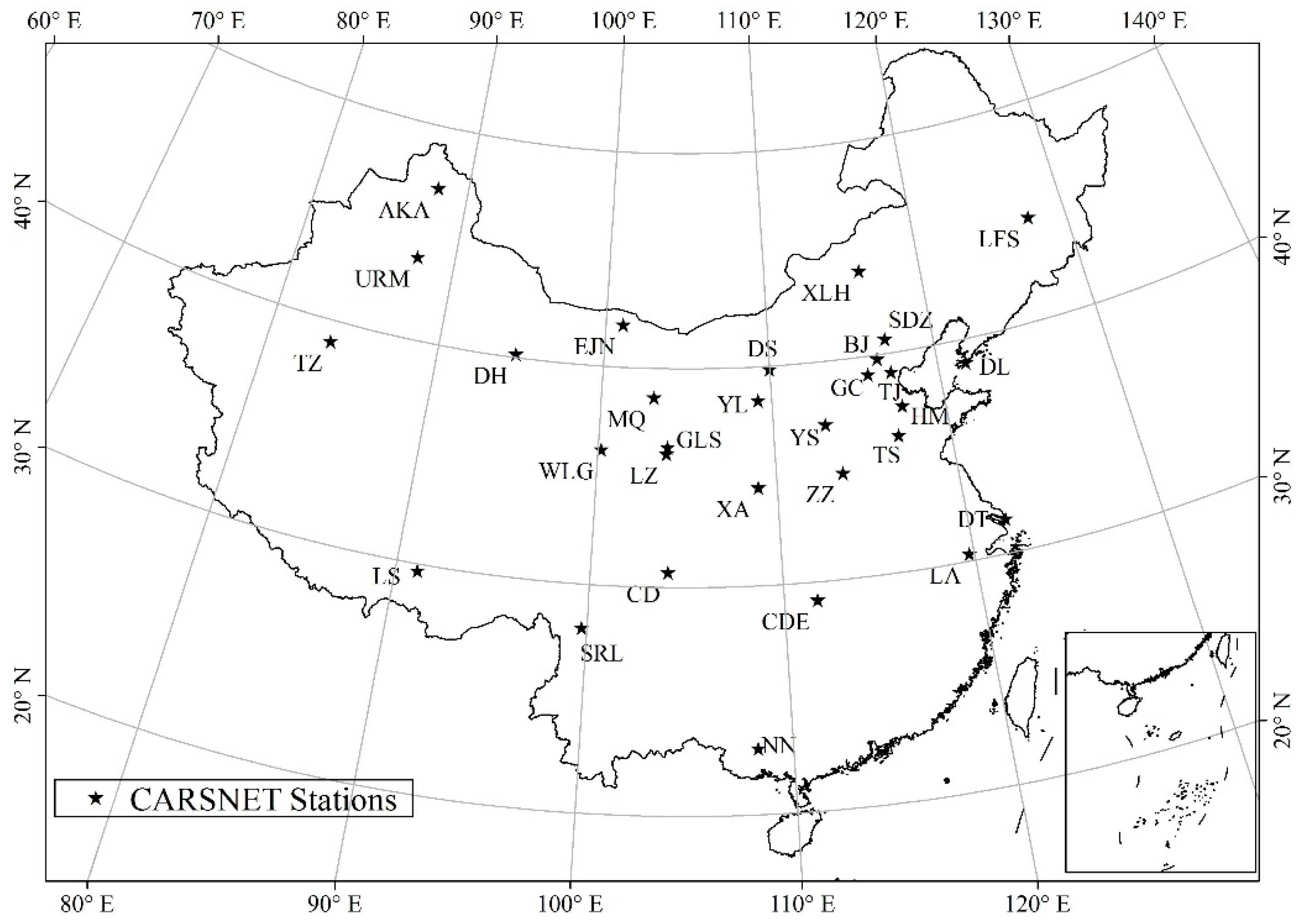
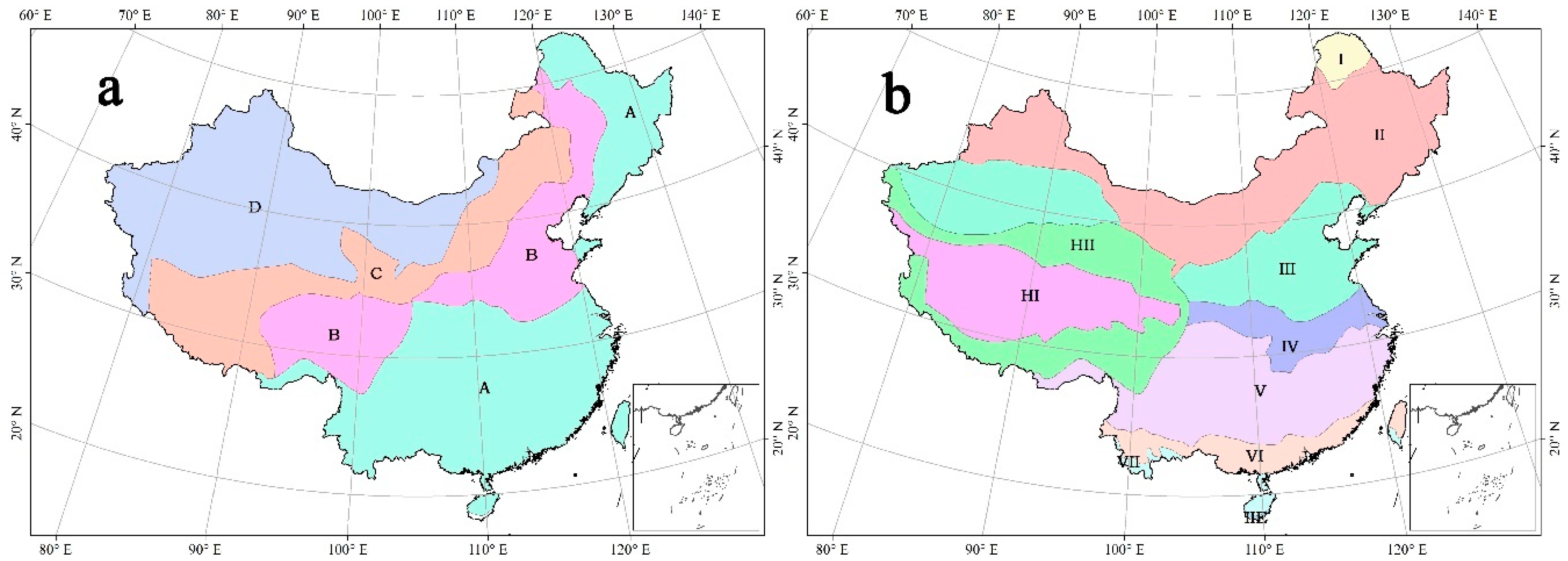
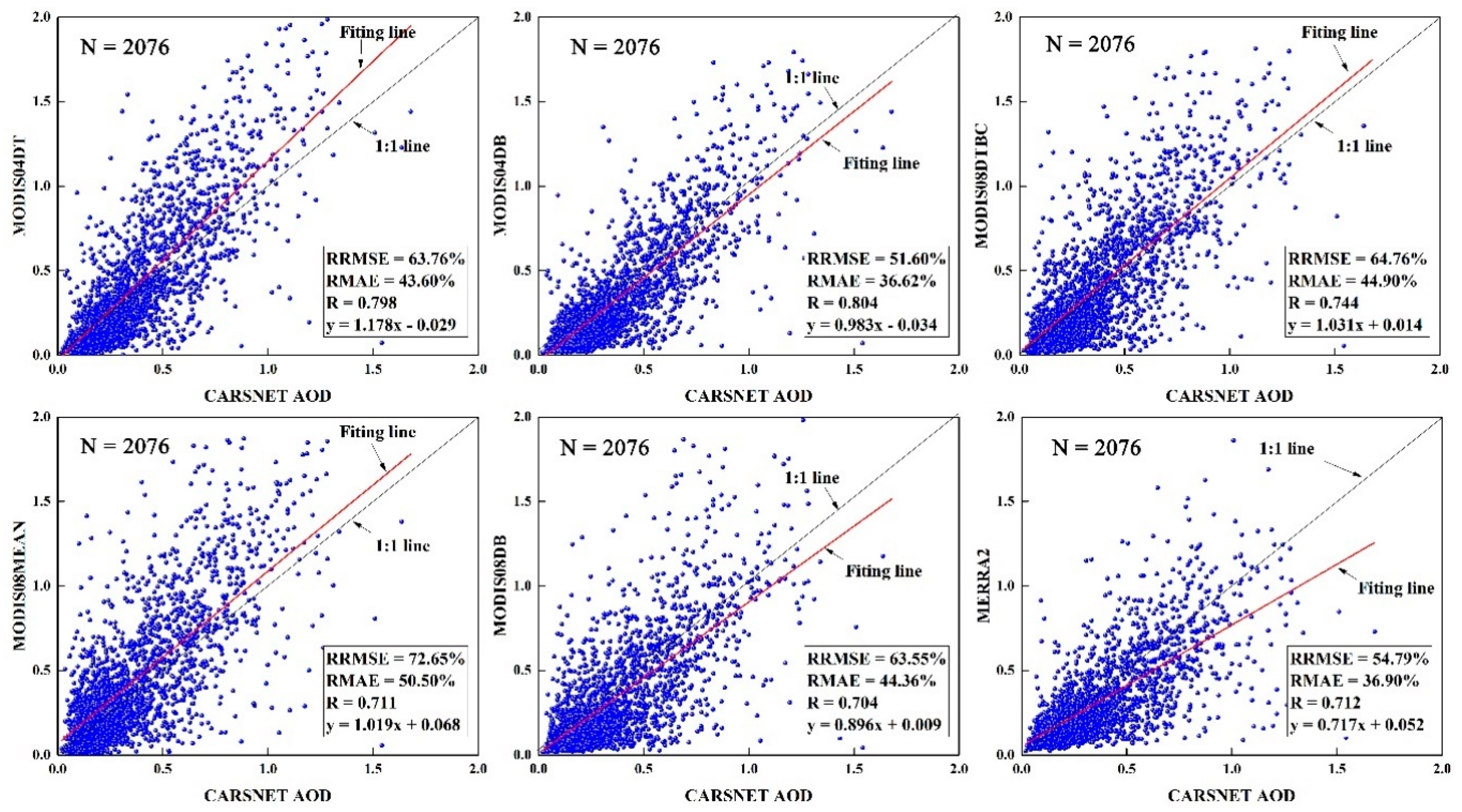
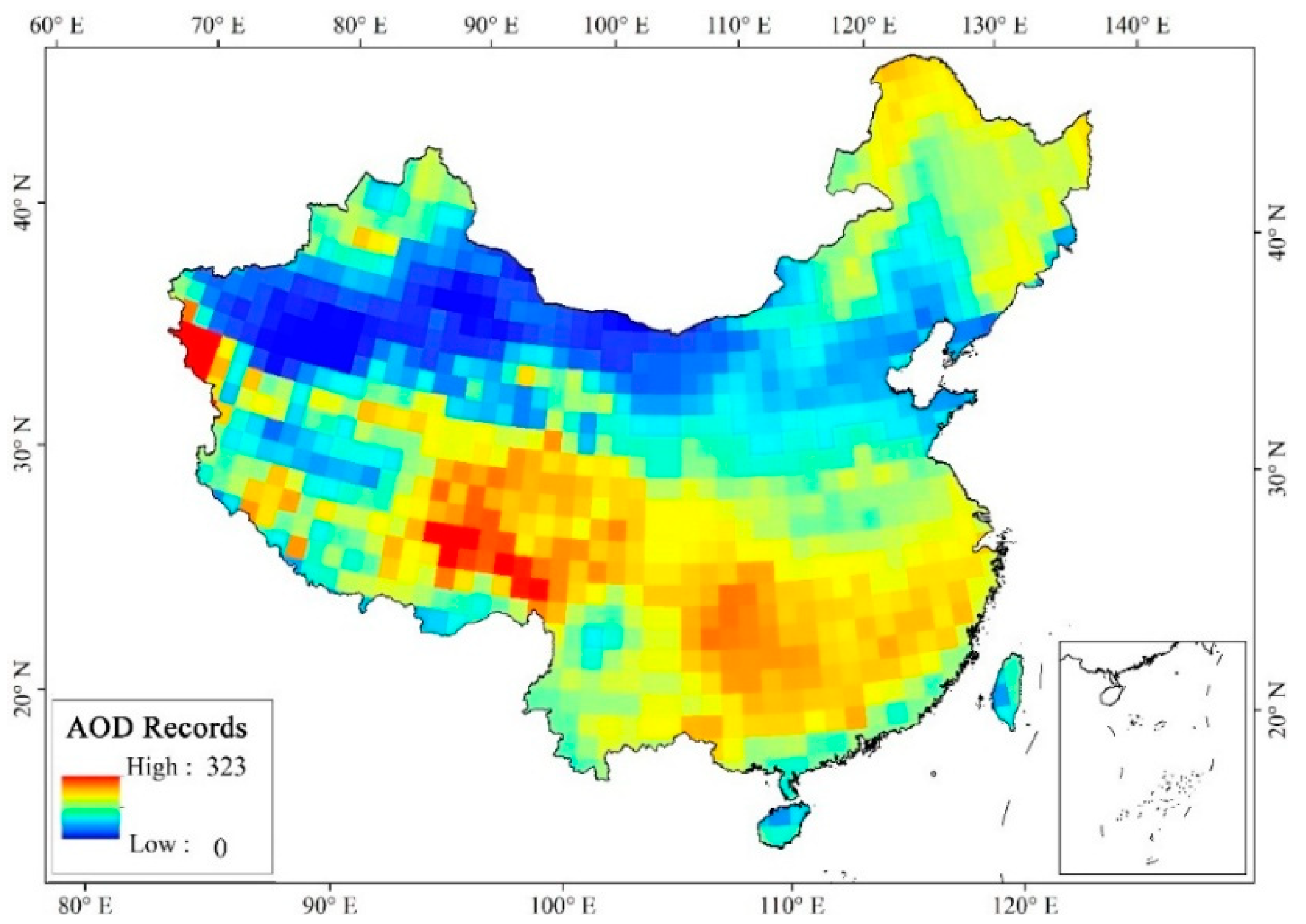

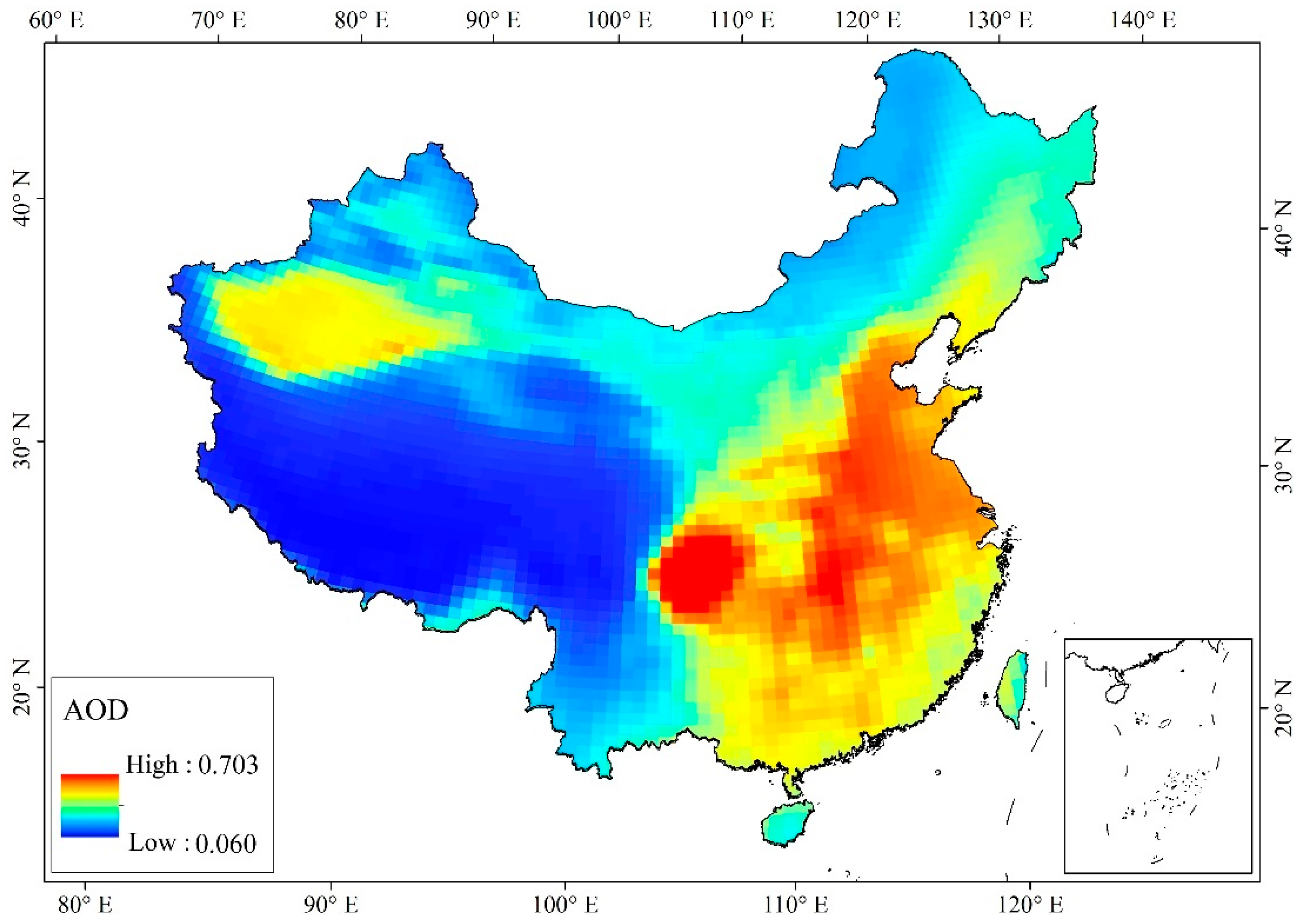



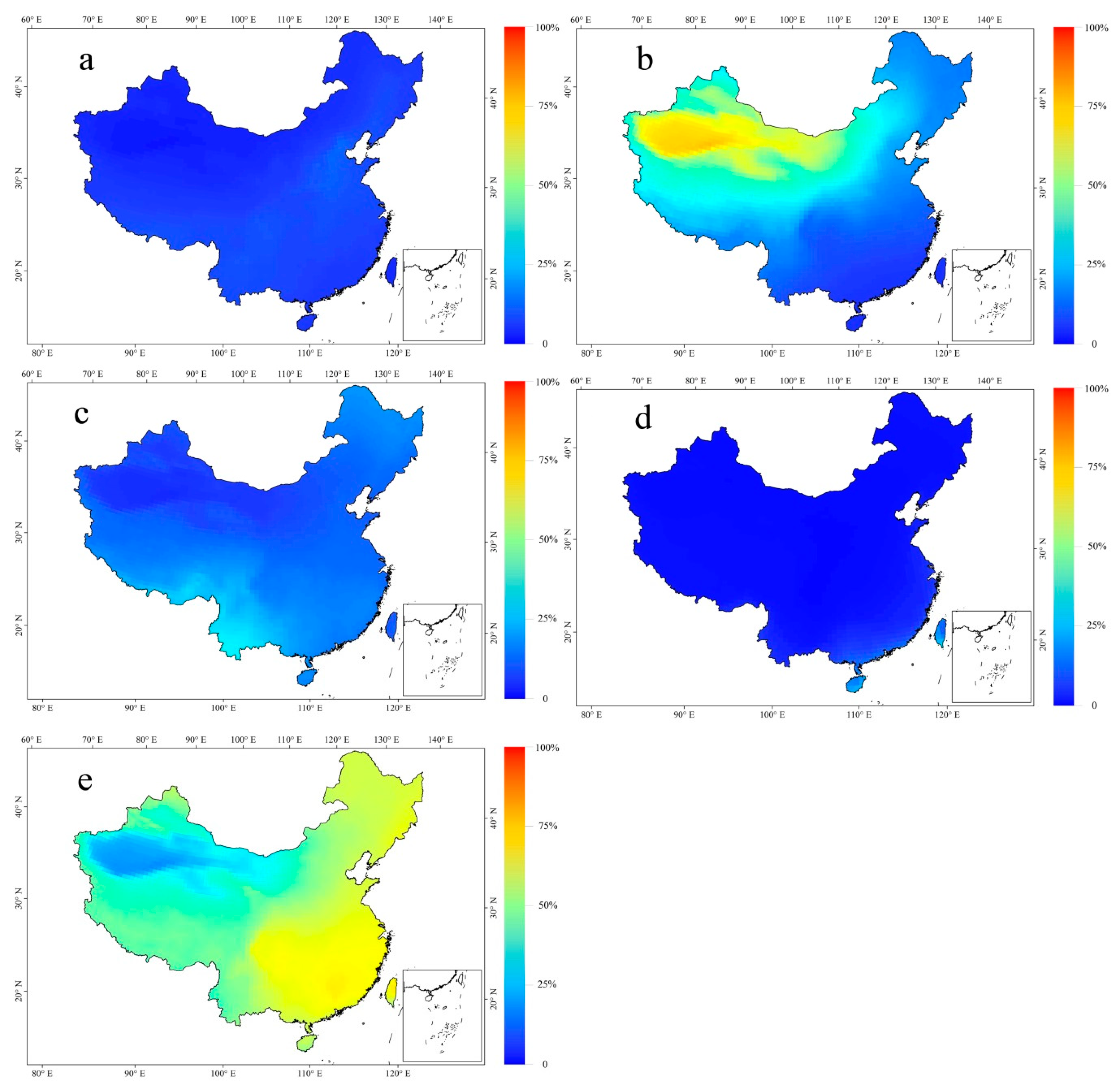


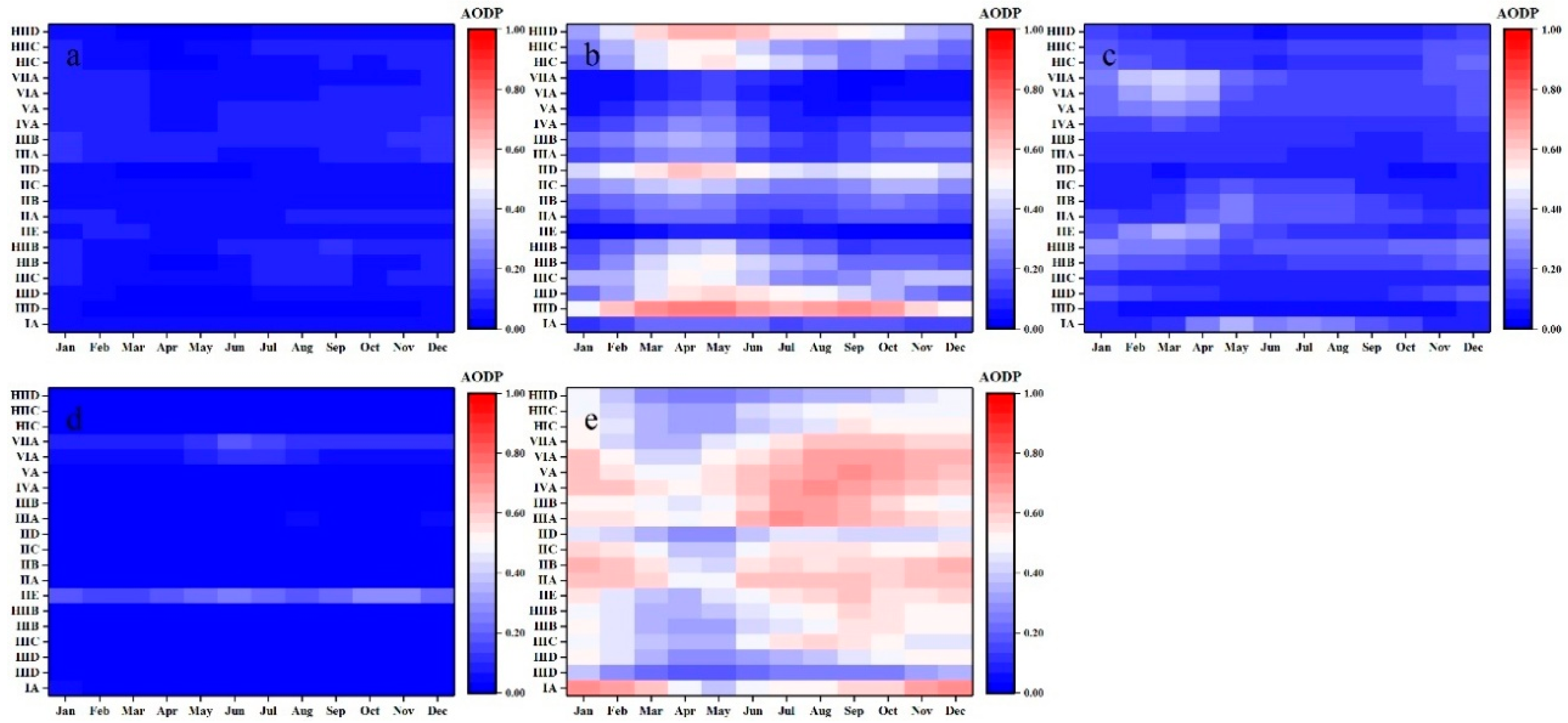
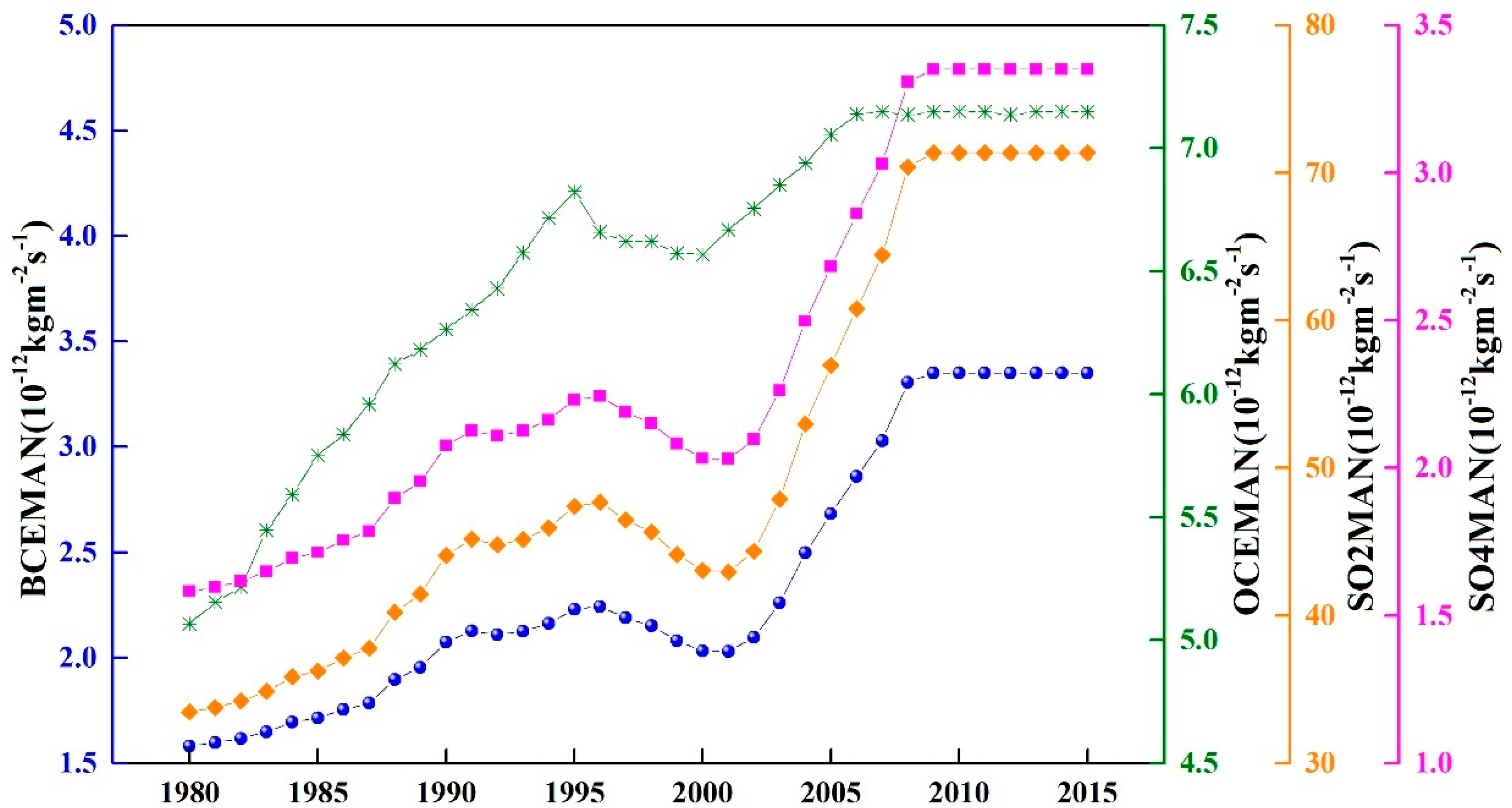


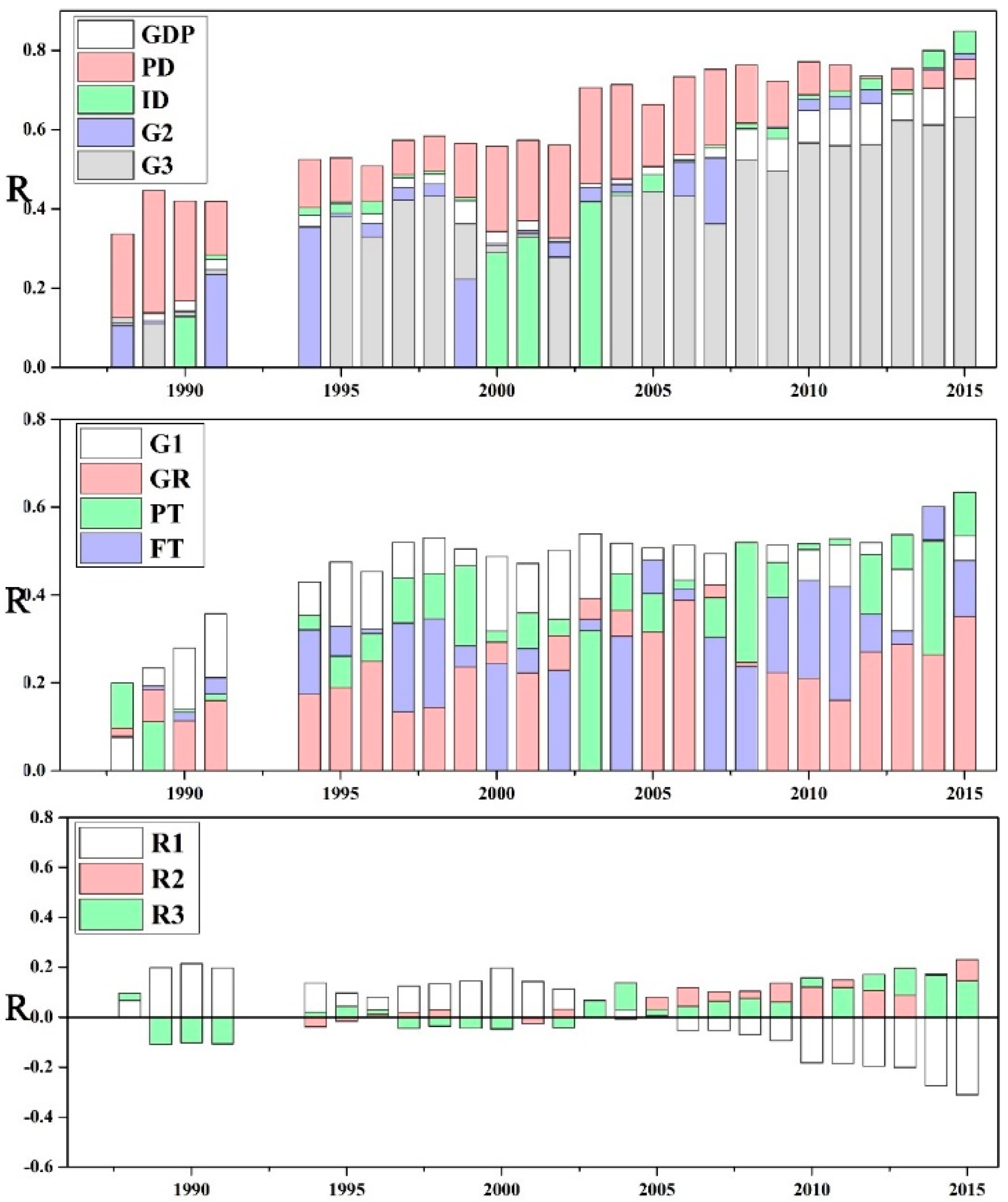
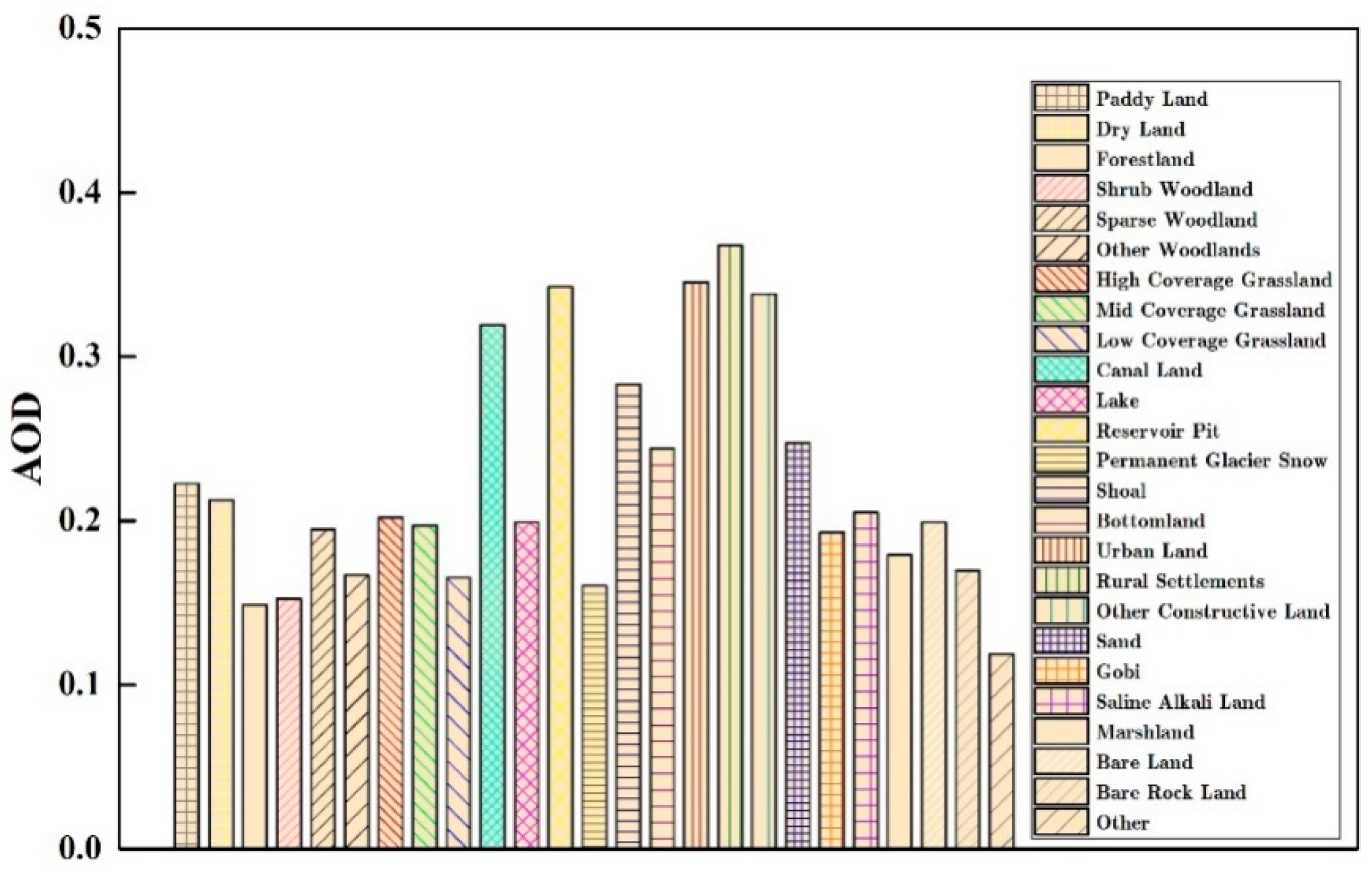
| Statistics | Lat (deg) | Lon (deg) | A (m) | P (hpa) | RH | SH (h) | T (°C) |
|---|---|---|---|---|---|---|---|
| max | 47.73° N | 126.77° E | 3648.9 | 1042.1 | 1.00 | 14.60 | 35.70 |
| min | 22.63° N | 79.93° E | 2.5 | 638.9 | 0.05 | 0.00 | −33.10 |
| mean | - | - | 856.9 | 922.7 | 0.56 | 6.59 | 11.49 |
| std | - | - | 956.7 | 99.1 | 0.21 | 4.11 | 12.06 |
| Dataset Name | Parameters | Spatial Resolution | Temporal Resolution | Temporal Range |
|---|---|---|---|---|
| MOD04_L2/MYD04_L2 | Aerosol optical depth (AOD, 550 nm) | 10 km | Instantaneously | 2002–2014 |
| MOD08_D3/MYD08_D3 | Aerosol optical depth (AOD, 550 nm) | 1° (lat) × 1° (lon) | Instantaneously | 2002–2014 |
| MERRA-2 | Aerosol optical depth (AOD, 550 nm) | 0.50° (lat) × 0.625° (lon) | Daily | 1980–2017 |
| anthropogenic aerosol emissions (BCEMAN, OCEMAN, SO2MAN and SO4MAN) | ||||
| AOD for dust aerosol (DUAOD, 550 nm) | ||||
| AOD for black carbon aerosol (BCAOD, 550 nm) | ||||
| AOD for organic carbon aerosol (OCAOD, 550 nm) | ||||
| AOD for Sea salt aerosol (SSAOD, 550 nm) | ||||
| AOD for SO4 aerosol (SO4AOD, 550 nm) |
© 2018 by the authors. Licensee MDPI, Basel, Switzerland. This article is an open access article distributed under the terms and conditions of the Creative Commons Attribution (CC BY) license (http://creativecommons.org/licenses/by/4.0/).
Share and Cite
Qin, W.; Liu, Y.; Wang, L.; Lin, A.; Xia, X.; Che, H.; Bilal, M.; Zhang, M. Characteristic and Driving Factors of Aerosol Optical Depth over Mainland China during 1980–2017. Remote Sens. 2018, 10, 1064. https://doi.org/10.3390/rs10071064
Qin W, Liu Y, Wang L, Lin A, Xia X, Che H, Bilal M, Zhang M. Characteristic and Driving Factors of Aerosol Optical Depth over Mainland China during 1980–2017. Remote Sensing. 2018; 10(7):1064. https://doi.org/10.3390/rs10071064
Chicago/Turabian StyleQin, Wenmin, Ying Liu, Lunche Wang, Aiwen Lin, Xiangao Xia, Huizheng Che, Muhammad Bilal, and Ming Zhang. 2018. "Characteristic and Driving Factors of Aerosol Optical Depth over Mainland China during 1980–2017" Remote Sensing 10, no. 7: 1064. https://doi.org/10.3390/rs10071064
APA StyleQin, W., Liu, Y., Wang, L., Lin, A., Xia, X., Che, H., Bilal, M., & Zhang, M. (2018). Characteristic and Driving Factors of Aerosol Optical Depth over Mainland China during 1980–2017. Remote Sensing, 10(7), 1064. https://doi.org/10.3390/rs10071064









